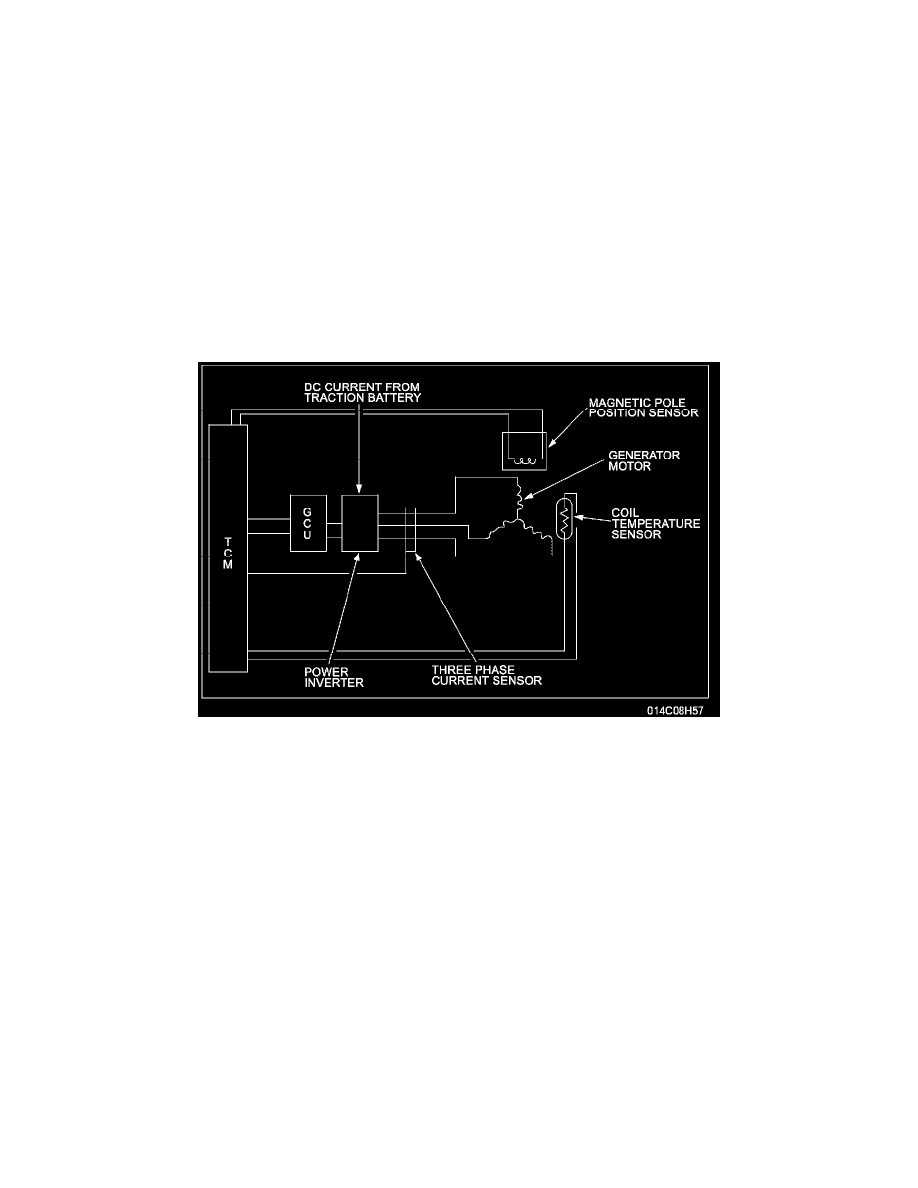Tribute 4WD L4-2.3L Hybrid (2008)

Drive Motor/Generator: Description and Operation
GENERATOR MOTOR
-
The generator motor is a 3-phase permanent magnet AC motor connected to the sun gear of the planetary gear set.
-
The generator power inverter (internal to the transaxle) receives a DC current from the high voltage traction battery. The DC current is inverted to
an AC current, which is controlled by the TCM and the generator control unit (GCU).
-
Depending on the mode of operation, the generator motor can rotate in the same (clockwise) or reverse (counter clockwise) direction as the
internal combustion engine.
-
The TCM also monitors generator position, speed, phase current, power inverter temperature, coil temperature, and voltage. It processes a variety
of PCM and traction battery control module (TBCM) inputs to determine generator function.
-
The inputs are divided into 2 categories: the hardwired signals and the network messages. The inputs are used to determine generator function
include the total torque desired, the engine speed desired, the generator mode, the generator shutdown, and the vehicle mode.
-
The generator operates in one of the following generator modes: torque, speed, engine cold start, engine normal start, engine high speed start, and
engine enhanced speed control stop.
-
The generator is used as a starter for the internal combustion engine, charges high voltage traction battery, and controls engine speed.
-
The TCM reports the generator error status to the PCM. The PCM initiates an appropriate limited operating strategy (LOS) mode and sets the
diagnostic trouble code (DTC) P1A0D (Hybrid powertrain control module - generator disabled) based on the error status it received. The TCM
also sets a DTC which indicates why the generator motor failed.
TRACTION MOTOR
-
The traction motor is a 3-phase permanent magnet AC motor connected to the ring gear of the planetary gear set.
-
The traction motor is connected to the drive wheels through a series of gears and rotates whenever the drive wheels rotate.
-
The traction motor power inverter (internal to the transaxle) receives a DC current from the high voltage traction battery. The DC current is
inverted to an AC current, which is controlled by the TCM and the motor control unit (MCU).
-
The traction motor can deliver positive torque by propelling the vehicle in the forward or reverse direction. It can also provide negative torque by
functioning as a generator during the regenerative braking.
-
The TCM receives input from the position sensor as well as the motor coil temperature sensor.
-
The TCM monitors the motor coil temperature and sets a DTC if the temperature exceeds a maximum threshold value. The TCM also monitors
motor position, speed, phase current, power inverter temperature, and voltage.
-
The TCM processes a variety of the inputs from the PCM and the traction battery control module (TBCM) to determine motor function. The
inputs are divided into 2 categories: the hardwired signals and the network messages.
-
The inputs used to determine motor function include the total torque desired, the motor inverter shutdown, and the vehicle mode.
-
The traction motor is used to provide torque to the axle shafts and recharge the high voltage traction battery during the regenerative braking.
-
The TCM reports the motor error status to the PCM. The PCM initiates an appropriate LOS mode and sets the DTC P1A0E (Hybrid powertrain
control module - traction motor disabled) based on the error status received. The TCM also sets a DTC which indicates why the traction motor
failed.
